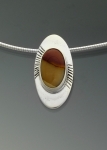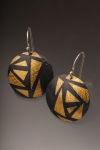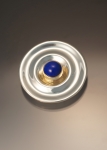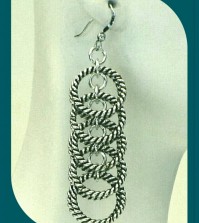- NEW DVD Series – Stone Setting with Bezels
- Tube Set Charm by Kim St. Jean
- Prong Basket Pendant by Kim St. Jean
- NEW DVD Series – Stone Setting with Cold Connections
- New DVD Series – Stone Setting with Wire
- NEW DVD Series: Introduction to Stone Setting by Kim St. Jean
- Featured Tool: Bracelet Bending Plier
- NEW Dvd by Eva Sherman
- Fun, Fast Fold Forming DVD Series
- Double Band Ear Cuff from Alex Simkin
Inspiration in Metal
Inspiration in Metal with Joe Korth
Joe Korth is a jewelry artist and metalsmith from Denver, Colorado. He was born in Berkeley, California in 1979. His first exposure to jewelry creation was in a high school art class. Joe continued his education at Eastern Michigan University where he earned a B.A. with a dual major in Philosophy and Literature. After completing his degree in 2002, he moved to Denver and began to explore his love for the arts.
He has devoted himself completely to jewelry since 2004. Joe has been an instructor at the Clear Creek Academy in Denver as well as the Armory Art Center in West Palm Beach, Florida, where he was an Artist-In-Residence from 2011-2012. Joe is currently the President of the Colorado Metalsmithing Association (COMA)
(audio not playing? click here)
Explore Joe’s Classes this February in Tucson:
|
2-Day Introductions to Silversmithing Feb. 1, 10:30 am – 6:00 pm and Feb. 2, 10:30am – 6:00pm |
Feb. 3, 10:30 am – 6:00 pm |
Feb 4, 2:30 pm – 6:00 pm |
Transcript of our interview with Joe Korth
Heather: So we are on the phone with Joe Korth, how are you doing Joe?
Joe: I’m doing great Heather. It’s nice to talk with you today.
Heather: Thanks for taking the time to talk with us today, let’s start by telling everyone which medium you primarily work in and basically you came to that medium?
Joe: Sure. Primarily at this point I work in precious metals, silver, gold, starting to use some platinum and palladium kind of to accent or add decorative parts in my work with semi-precious and precious stones. I do some work that doesn’t have stones in it and then I do pieces that are primarily about the stone and the metal is acting as an addition to the stone.
Heather: Is that your first medium you chose or how did you arrive at that?
Joe: I didn’t go to school for fine arts but when I was in high school I took art classes, ceramics, some drawing and painting and a jewelry class. I was lucky enough to go to a high school that had a jewelry class. I definitely immediately gravitated towards the 3D medium. I like the hands on aspect of building things with dimension. Then I went to college and got my bachelors in philosophy and literature but during that time for elective classes I took jewelry primarily. Pretty much since the beginning my focus has been on metals and metalsmithing. For me it’s been the opposite of what some people go through as far as trying all sorts of different media and then picking the one they like the best. For me I started in metals and then as I’ve worked metals for about 10 years now, I’m interested in branching out to different media and focusing a little more on drawing and ceramics as a way to expand my creative pursuit beyond just jewelry and metals.
Heather: Wonderful. What are some of the tools you use most often?
Joe: I still use the basic stuff that I was shown my first or second jewelry making class. Hand tools like jewelry saw, variety of files, sanding sticks, and basic larger pieces of equipment like torches and a flex shaft. With these basic sets of tools you can do almost everything. Some of the more specialized tools are very helpful for making particular tasks easier or faster but never absolutely necessary so that is cool that you can do a lot with very little. A couple things I do use constantly are digital calipers. I like to wear an apron when I’m working just to keep clean and so my apron has pockets and the things that are always on me in the apron are digital caliper, my safety glasses, and an ultra fine sharpie pen and some gloves. The only tool out of those is a digital caliper but that is something I have constant use for.
Heather: Have you ever improvised a tool or repurposed a tool?
Joe: This is a funny question. Yes certainly I have. There are certain tools we use in jewelry that have to be in usable condition i.e. engraves, certain hammers, they’re going to have to be refinished or made to the correct length for the person but there are also tools that are used in a totally different way than they were originally designed. Small little burs or broken or old drill bits can be useful for making it into a little tool for stone setting. A good one is if you need to make a repair and take a stone out of a bezel, I’ve made a tool out of an old bur that has been forged into a real thin tip like the thinness of a piece of paper and you slide that between the stone and the bezel to open that up. And my favorite repurposed thing which I wish I could claim credit for but I learned from another jeweler, if you take a bunch of old CDs and glue sandpaper to the surfaces and you can put that on the polishing arbor/buff machine and will act as a flat spinning sanding surface. That’s extremely useful and someone really had a good idea doing that.
Heather: That’s awesome. What’s your favorite way to finish a piece or your favorite effect?
Joe: I can’t say that I have a favorite. Certain pieces for me, really matte or satin finish is a more appropriate choices, certain other pieces I do a patina. I do a lot with patinas for coloring and then other pieces I high finish all the way to a mirror finish and that’s something that I think is really important to be able to do. Whether or not you like the look of the high or mirror finish, being able to create that is really really important. I learned a lot from a custom jeweler in Denver, Kathy Pritchett. I worked a lot with her and learned a lot from her over the years. Learning from a custom jeweler is great technically. If you are making custom jewelry you have to be able to make things look flawless and a big part of that is the finish. It’s the difference between a really amazing finished piece and a so-so piece is often in the finish. Being able to really create a perfect mirror finish is a skill that’s very important in jewelry making. Even if I do a matte finish or if I patina, often times I’ll take it to a really high finish first and get it really homogenous and perfect and then the matte or satin finish or whatever else I’m doing is that much better after doing the polishing to make it nice and uniform.
Heather: What advice would you give a beginning who may be a bit intimidated by how intricate the process seems?
Joe: This is a great question. My take on this is that you really don’t need to have a lot of technique to do amazing and fun and creative things. With just a simple of technique as learning how to saw metal, you can do amazing things. If you look at some of the mid-century modern jewelers, Art Smith and Alexander Calder, a lot of it is very simple; taking wire and bending it into different shapes or taking designs and just cutting them out of sheet metal and putting them together with something. It’s easy to get caught up in the vast number of techniques that are available and all the equipment, but really with a bench pin and a saw and some files and a hammer, you can do a lot. It’s about creativity more than mastering every possible technique. I think that’s really a good lesson is the point is about having fun, practicing, and playing with the techniques you’ve learning rather than constantly trying to add more techniques to your repertoire. Keeping it simple is good and it’s about being creative and having fun with the process.
Heather: Great. Once you make a piece that you’re happy with, where does it go?
Joe: I work with a number of galleries in Colorado and New York. My finished work tends to go to those places. I tend to work in groupings so I’ll be working on multiple pieces at the same times always. When I finish stuff I usually finish them in groups of 3 or 5 or 8. Then once I have a group of a body of work, that will go to one of those galleries that I mentioned. I have different things in each of those galleries. One of the galleries is more gold/solid gold work; little higher end with materials and little more conservative as far as esthetics. The gallery in New York is a very high level art jewelry gallery and so there it’s about a specific line of work I do with lots of colored stones and more edgy and creative, very non-traditional as far as what that work looks like. There are pieces I definitely keep or I give them as gifts. If it’s something I’ve done once and it’s never something I’m going to do again or fit into a collection or pieces I thought were very successful and that I like personally I keep. I do wear jewelry so there’s a couple rings I’ve kept that I’ve really felt personally attached to but the rest go to a gallery.
Heather: What gives you inspiration to try new things? What keeps you motivated?
Joe: It’s not always easy. Being a working artist is a difficult job. I did production work for a lady in Denver for about 5 years where it was her business; obviously, I was just the silversmith making the work. On some level that is vastly easier than being your own boss. Being a working artist and the discipline of that can be very challenging. For me deadlines are absolutely necessary. Either having a show or having to send work to a gallery or a teaching event or competition, those external motivators are helpful to really get me in the studio working hard. I tend to be very typical in working. There will be periods of time especially before a deadline where I’m in the studio 12 hours a day for weeks. And then typically after that there will be a break time where I’m in the studio very little and that’s how I tend to work in the shop. There are times when you need to create for yourself, so some great advice I was given one time from a jeweler I know is first thing if you aren’t feeling motivated, just go out in the shop and clean up. Just being in the shop can be great to get in the groove or get in the mode of being in the shop so just doing simple things like organizing or cleaning can be helpful. Something what always motivates me is looking at other peoples work. Whether that’s in a gallery somewhere, or in a book or magazine, or at the conference of some type; just seeing other people’s work, especially very successful and high level work always motivates me to get in the shop and not necessarily duplicate what they are doing but to continue forward in my own artistic endeavor/process and just trying to continue forward. I think experimentation and play is also very important and that’s something I’ve learned from my good friend Michael Boyd who is a jeweler in Colorado as well. Sometimes going out to the studio without a fixed or preconceived notion is really good. Just going out and experimenting with different ideas can be really a fun process. It’s important to enjoy what we are doing and not be completely goal driven and if it doesn’t come out exactly how we wanted not to be unhappy. Often going out to the studio with less concrete ideas of what I want to do is more filling because there is spontaneity and the creative process is more open. So that’s another thing I’ve learned is just to be open minded and go out and play and follow whatever path the works leads me in.
Heather: So you’ve been making and teaching jewelry for years now, what have you noticed about your work that has evolved?
Joe: I think on some level I understand myself as an artist now. I know what I like doing and what I don’t like doing as far as the actual work. There are certain techniques that I’m absolutely capable of doing, I just doing like doing them. I tend to be very left brain and structured and symmetrical. I’m kind of engineering oriented and so in the beginning especially and still now I tend to design things that are tight artistically and from a technique stand point that needs to be executed flawlessly and I’m trying to shy away from that work because it’s not fun as much. There isn’t spontaneity in that work and it’s has such a necessity for perfection that kind of takes the fun out of the work for me. I’m doing some work that is definitely much more loose; that has more irregular form and textures. I think something that has happened over the last couple years is that I’ve learned to trust myself artistically and my esthetic sensibility. I think in the beginning I made very simple things and this is common, I see this all the time with students. In the beginning you start with simple things as far as designs, and that’s good on some level for learning because you need to start with simple designs otherwise it’s too difficult to finish things. But at a certain point I was making very simple things because I was afraid that I’d make something that I didn’t like and so instead of taking a risk and trying something beyond my comfort zone, I would just keep things simple because I knew it was comfortable and safe but in the last couple years I’ve learned to trust my ideas and learn to trust that not everyone is going to like something edgier and more creative; not everyone is going to like that and it’s ok. What’s important for me is that I like it and that it’s true to my esthetic sensibility and on some level getting over what people think of the work has been a lesson I’ve learned and also related to that is willing to be able to take risks of the work. Making things that you don’t’ like is just as important as making things that are successful and we do like. That’s something I’ve learned in the past couple of years.
Heather: What’s something that you’ve learned from one of your students?
Joe: I think primarily the thing that I learn from students on a regular basis is open-mindedness. Not a lot of technical information I would say, I’m sure students have taught me technical things over the years but not that I can think of. The students are often coming from a very innocent place as far as working that they don’t necessarily know what the rules are so they think out of the box in creative ways often. That’s really informative for me because once you learn the rules of how to do things, it’s easy to get trapped in that box and think that there is only one way of doings things. The students really come up with creative ideas as far as design or function of pieces or things that are way outside the norm as far as technique and that’s really cool. Some of those things are very useful. One of the things about jewelry making and silversmithing is there is more than one way to get to an end result. Sometimes there’s better or worse ways of doing things and sometimes there are just many things that are personal preference as far as ways people like working and that’s important to remember also. When I teach I try to teach the most efficient and effective way that I’m aware of to the students but it’s also important to be open minded as far as different input from them and different ways of doing things.
Heather: Why do you think people like to wear jewelry? And why do you think people love to make jewelry?
Joe: There are a variety of answers to that. There are a lot of things jewelry can be. It can be a sign of prestige and wealth, it can be a display of our personal artistic preferences, and it can be personal adornment and decoration. As far as what I do, in the realm of more art jewelry, I think that the personal nature is really unique in the art world. If you think about sculpture or painting, these are things that we have in our home that are personal but not necessarily something we are wearing on our person. Jewelry is unique that it somehow reflects the wearer and has a relationship with the wearer that is different than is a piece in someone’s home. That’s really neat and that’s the desire to decorate ourselves. It’s something that’s been for thousands of years. It’s the desire to add to our own personal beauty as human beings. I think that’s often many of the reasons people wear jewelry. Now why people make jewelry? It’s such an interesting question and for me and it’s important to look at “why do I make art, specifically jewelry?” Jewelry is neat because it’s at a crossroads between science and art on some level. Similar to architecture in that there is a strong point or there can be a strong point of creative expression and beauty and creating a new thing in the world but there is also a strong craft part as well of making something. I see people in classes a lot that come from engineering and computer backgrounds; left brain people. I think jewelry is great for those people because the process is very architectural and scientific in some ways. Some people love to learn about the melting points and the hardness of stones and all the different technical information and there is a lot of that in jewelry making but there is also a lot of creative expression and design so it’s neat in the sense that it has both of those things.
Heather: That’s great. So you’ve been active in the Metalsmithing community serving as president of the Colorado Metalsmithing Association. How long have you been involved? How long have you been president? And what kind of experience has this been for you and how has it affected your craft?
Joe: We’re very blessed in Colorado to have an exceptional membership of people that live in Colorado doing very high level art jewelry. There are a number of people that are very well known nationally and there are many people making high level work. Our field in Colorado is exceptionally good and talented and we’re very fortunate to have that. I’ve been on the board for 5 years. I was on the board for 3 years and I came to Florida for a residency at an art center for a year so I wasn’t on the board. Then I came back to Colorado last year and I started the term that year as president. So that’s a 2 year term 2013 and 2014. It’s an amazing group of people. We have a conference in Salida Colorado every year for I think 18 and 19 years now. That really has become one of the top couple art jewelry conferences in the US. We get absolutely the best people in the United States and in the world to come and talk about their work and do workshops. We have had many very well known people, Berndt Munsteiner, Mary Lee Hu, Michael Zoble, Michael Good, Albert Paley along with other extremely talented and well known people. For one, just being a part of that organization, not even on the board but just as a member going to conferences where people of that level are presenting, is extremely beneficial. I’m a strong believer the more good work you are exposed to, will raise the level of your own work. That certainly has been true for me. Seeing the absolute best work that is being made has really pushed me to take my own work to a higher level, so that’s been great. Being on the board, I’ve gotten to know many of these people on the personal level which has been an amazing opportunity to become friends these people and to give back to the organization. Professionally it helps me immeasurably that the contacts and things that I’ve learned from people in the organization has been great. It’s given me an opportunity to give back. I went to the conference and was a member for the last 8 or 9 years so there were a couple years where I was just being a member and reaping the benefits of that. Then I was asked to be on the board and I felt it was my responsibility to put in some work. It’s very time consuming, it’s a big commitment but it’s certainly been well worth the effort I’ve put in for myself and for the organization. I’m happy to have the opportunity to be of service.
Heather: That’s good to hear. Thank you so much Joe! Thank you for taking the time and allowing me to pick your brain a little bit and give our listeners a better feel for you. Joe will be teaching with us this year at the JOGS show. He will be having a 2-day Silversmithing class along with some other classes available so hopefully everybody can come take a class and have the opportunity to learn from you!
Joe: Thanks! Looking forward to seeing you all in Tucson!
Don’t Miss Joe in Tucson!
|
Feb. 1, 10:30 am – 6:00 pm and Feb. 2, 10:30am – 6:00pm |
Feb. 3, 10:30 am – 6:00 pm |
Feb 4, 2:30 pm – 6:00 pm |


























Ron Fogh
December 24, 2013 at 3:11 pm
Hi,
I have been making earrings and necklaces for the past several years. But would like to learn how to use a torch and silversmithing in making some good pieces for a higher price. O really like working with sterling silver and turquoise and red coral. Do you think you could help me out with this as there is not much out there in the way of teachers of this art. Thanking you in advance, Ron..